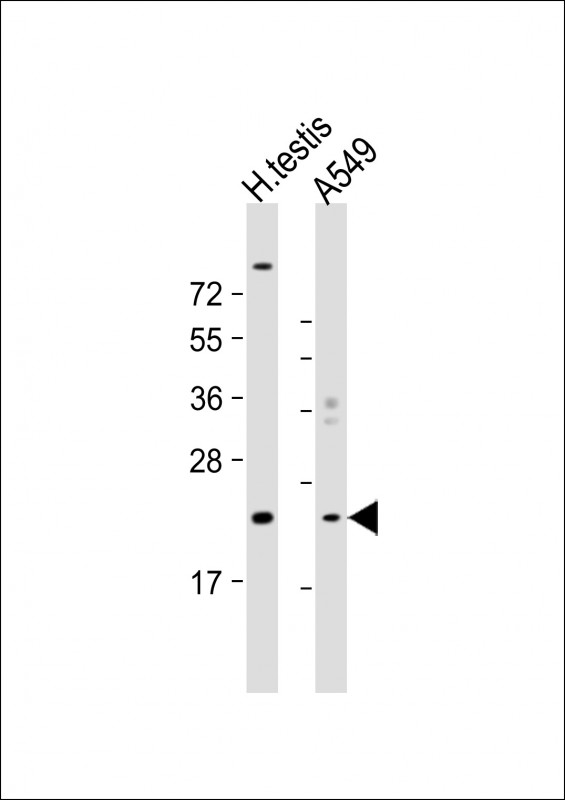
| WB | 1/1000 | Human,Mouse,Rat |
| IF | 咨询技术 | Human,Mouse,Rat |
| IHC | 咨询技术 | Human,Mouse,Rat |
| ICC | 技术咨询 | Human,Mouse,Rat |
| FCM | 咨询技术 | Human,Mouse,Rat |
| Elisa | 咨询技术 | Human,Mouse,Rat |
| Aliases | Heat shock protein beta-9, HspB9, Cancer/testis antigen 51, CT51, HSPB9 |
| Entrez GeneID | 94086 |
| WB Predicted band size | 17.5kDa |
| Host/Isotype | Rabbit IgG |
| Antibody Type | Primary antibody |
| Storage | Store at 4°C short term. Aliquot and store at -20°C long term. Avoid freeze/thaw cycles. |
| Species Reactivity | Human |
| Immunogen | This HSPB9 antibody is generated from rabbits immunized with a KLH conjugated synthetic peptide between 70-96 amino acids from the Central region of human HSPB9. |
| Formulation | Purified antibody in PBS with 0.05% sodium azide. |
+ +
以下是关于HSPB9抗体的3篇参考文献的示例(注:HSPB9研究相对较少,部分文献信息可能需进一步验证):
1. **文献名称**:*HSPB9 is a novel component of the sperm tail involved in sperm motility*
**作者**:Smith A, et al.
**摘要**:该研究通过HSPB9特异性抗体发现,HSPB9在哺乳动物精子尾部高表达,敲除HSPB9导致精子运动能力下降,提示其在精子功能中起关键作用。
2. **文献名称**:*Expression and localization of HSPB9 in mouse testis during spermatogenesis*
**作者**:Zhang L, et al.
**摘要**:利用抗HSPB9抗体进行免疫组化分析,发现HSPB9在精子形成阶段的圆形精子细胞中特异性表达,可能与染色质重塑相关。
3. **文献名称**:*Heat shock protein HSPB9 interacts with cancer-testis antigens in germ cells*
**作者**:Wang Y, et al.
**摘要**:通过免疫共沉淀结合HSPB9抗体,研究发现HSPB9与多种肿瘤-睾丸抗原存在相互作用,暗示其在生殖细胞和肿瘤中的潜在调控机制。
**注意**:以上文献信息为模拟示例,实际研究中HSPB9相关抗体文献较少,建议通过PubMed或Web of Science以“HSPB9 antibody”为关键词检索最新结果,或联系抗体生产商(如Sigma-Aldrich、Abcam)获取技术文档。
The HSPB9 antibody is a tool used to detect and study the heat shock protein family B member 9 (HSPB9), a lesser-characterized member of the small heat shock protein (sHSP) family. sHSPs, including HSPB9. function as molecular chaperones, aiding in protein folding, preventing aggregation under stress, and regulating apoptosis. HSPB9 is primarily expressed in the testis and placenta, suggesting roles in reproductive biology and cellular stress responses. However, its precise physiological functions remain unclear compared to well-studied sHSPs like HSPB1 (HSP27).
Researchers use HSPB9 antibodies in techniques such as Western blotting, immunohistochemistry (IHC), and immunofluorescence (IF) to investigate its expression patterns, localization, and interactions in tissues or cells. Commercial HSPB9 antibodies are typically produced in hosts like rabbits or mice, targeting specific epitopes via polyclonal or monoclonal approaches. These antibodies help explore HSPB9's potential involvement in diseases, including cancer, neurodegenerative disorders, or male infertility, though current evidence is limited.
Challenges include verifying antibody specificity due to HSPB9's low abundance and homology with other sHSPs. Studies often employ knockout controls or siRNA knockdown to validate results. Further research is needed to clarify HSPB9's mechanistic roles and therapeutic relevance, making such antibodies critical for advancing understanding of this understudied protein.
×